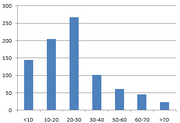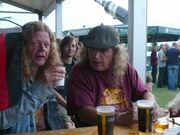
Age structure of the Limburgish community in indices.
Limburgish cultural expressions and people are mostly concentrated in Oceana and European-minded neighborhoods of Noble City. Generally speaking, the people are between the ages ten and thirty, mostly immigrants, and they are Roman-Catholic. Their main shop, De Limburger, can be found only in Hurbanova. Their feast is November 11, d'n èllefdje ven g'm èllefdje. Although they are considered not to be one of the main groups of the Lovian population, they make up about 7,2% of the population of Oceana and are one of the fastest growing ethnic communities of the state. They have a relatively low population number in East Hills.
Much Limburgish culture has entered Lovia via Mäöres.
Politics[]
The common interest of most Limburgish immigrants is being represented by the Limburgish Minority Party (LMP). Still, most Limburgish people tend to vote MCP or CCPL. Other broadly supported parties include the UL and CNP.
Language[]
The Limburgish language has nowhere in Lovia been made official. Most Limburgish people don't care about that. Probably there are some 5.000 to 10.000 people in Lovia that have some knowledge of the language. Some 3.000 speak it natively. It is mostly used privately. Most people speak Mäöreser dialects, with the majority speaking standard High Limburgish. Other typical dialects include Saenteimerplat and other non-standard sociodialects.
Most Limburgish people in Lovia speak English. While the effect of English on their Limburgish skills and phonology is hardly noticeable; the effect of Limburgish on their second language English is very clear. Especially the distinctive tonality of Limburgish and lack of certain sounds (which are then being replaced by Limburgish countervalues) can be observed. Typical Limburgish pronunciation is illustrated by a transcription of the introduction to the page Lovia in IPA:
- /ˈlóːvɪ̯ɐ̀ | ɦoˈfɪ́ʃɐlìː ðɐ ˈkɪ̀ŋgdóm òv ˈlóːvɪ̯ɐ̀ɪ̯z ɐn ˈɑ̀ɪ̯láɲ ˈnèɪ̯ʃɐn ɪ́n ðɐ ˈnɒ̀ːɾðɐn pɐˈsɪ́vɪ́g ˈòːʃɐ | kōnˈdzɪ́stɪ̄ŋg òv ðìj ˈɑ̀ɪ̯lándz òv ðɐ ˈlóːvɪ̯ɐ̀n ˈɑ̀ɾkɪ̄pæ̀léːɣòː òv ðɐ kǽlɪ̄ˈfóɾnɪ̯ɐ̀ ˈkòːs || ˈlóːvɪ̯ɐ̀ɪ̯z ɐn ˈdzúːvɐɾéːn ˈkónstɪ̄tʃúːʃɐnɐ̄l ǽn ˈpɑ̀ɾlɪ̯ɐ̀mǽntɐl ˈmònɐxìː || ðɐ ˈkǽpɪ̄tɐ̄l ǽn mòːs ˈpópɪ̯ùːlɐ ˈzɪ́tìːz ˈnóːbɐl ˈzɪ́tìː/
Food[]
Limburgish food can yet only be bought in Hurbanova. Limburgish food includes flaaj (some sort of pie), sjuumke trèkke (a bottle of water with a root of a plant in it which gives it a sweet taste), zoersmoos (a cooked vegetable), kestieëlwien (wine), kroepoed (baked pig blood), smètterling (a sort of pudding), stóksvleisj (meat cooked in much water) and of course beer (Limburgish beer, like alfa, brand, gulpener etc.).
Mäöres[]
As the majority of the Limburgish people living in Lovia have been born in Mäöres or are second generation Lovians with parents coming from that country, the ties with Mäöres are still very strong. Many of them visit family in Mäöres at least once a year. Mäöreser people have massively left their country of origin in the past and thus they might also visit other countries. Countries with a large Mäöreser minority are:
- Germany: 48,000
- Mäöres: 30,000 (a majority)
- The Netherlands: 15,000
- India: 11,000
- Belgium: 7,000
- Eathland: 5,000
- United States: 5,000
- South Africa: 4,000
- Australia: 3,000
- France: 3,000
- New Zealand: 2,200
- Lovia: 2,000
- Sri Lanka: 1,500
- Sweden: 1,500
Stereotype[]

Stereotypical Mäöreser immigrants: uneducated, poor hygiene, and alcoholism.
Mäöreser immigrants are often viewed negatively by Lovians, partly because of their reputation for coming and 'stealing Lovian jobs' and partly because as the most recent immigrant group they are not yet fully integrated. Oos Wes Ilava has commented that the Mäöreser stereotype was 'poor, criminal and hated.' As a general rule, Mäöresers do tend to be poorer than other Lovians and to work in manual jobs. Nevertheless, several have been very successful in politics, the prime example being Ilava himself, the Prime Minister for 2012.
Famous Lovian people of Limburgish ancestry[]
- Oos Wes Ilava (partially): politician, ex-criminal, linguist and Limburgish separatist.
- Ben Opať (partially): politician, of Dutch, Limburgish and Lovian ancestry.
- Bart Koenen: architect and creator of Drake Town, Millstreet and the original Newport industrial area.
- Bèddel Maerzich: singer-songwriter.
- Joean Góldhammer: politician.
- Martijn Mans: businessman and politician.